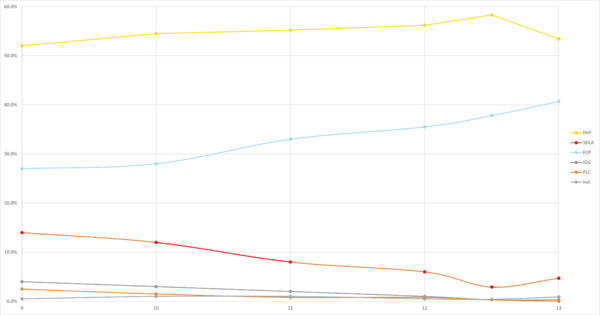New Alexandrian general election, 1718

|
This article or section is a work in progress. The information below may be incomplete, outdated, or subject to change. |
| |||||||||||||||||||||||||||||||||||||||||||||||||||||||||||||||||||||||||||||||||||||||||||||||||||||||
| |||||||||||||||||||||||||||||||||||||||||||||||||||||||||||||||||||||||||||||||||||||||||||||||||||||||
| |||||||||||||||||||||||||||||||||||||||||||||||||||||||||||||||||||||||||||||||||||||||||||||||||||||||
The New Alexandrian general election of 1718 was the sixth general election of the Federation of Nouvelle Alexandrie after its formation in 1685 AN. It was held over the course of three days, from 1.XIV.1718 AN - 3.XIV.1718 AN. The election campaign was marked by various critical events and issues that influenced the final results. Operation Purple Splendor, the death of King Manco Cápac I and the subsequent coronation of King Sinchi Roca I occurred only months before the start of the campaign, impacting the political discourse. Furthermore, the Libertygate scandal involving the People's Liberty Congress led to the arrest of its leader, Adriana Lopez-Gautier, and severely damaged the party's prospects in the election. This election witnessed the formation of the 6th Cortes Federales, specifically its lower and elected chamber, the Federal Assembly. The election followed a mixed-member proportional representation system, with 661 seats up for grabs. The 1718 election saw 105,675,247 votes cast, a turnout rate of 56.1%, a marked increase from the previous election.
In the lead-up to the election, the Federal Humanist Party (FHP) was expected to maintain its majority in the Cortes. Despite losing 35 seats, the FHP did indeed secure a majority of 22 seats. The Social Democratic & Liberal Alliance (SDLA), however, suffered a significant defeat, losing 129 seats and dropping to the third-largest party behind the Federal Consensus Party (FCP). The FCP emerged as the largest opposition party, winning a total of 247 seats, many of which were captured from the SDLA and the Independent Deputies' Group (IDG).
The election results varied across the different regions of the Federation of Nouvelle Alexandrie. The FHP gained a majority in Alduria and Wechua Nation, with the latter being heavily influenced by the party's focus on Wechua culture and the death of King Manco Cápac. Santander, a traditionally right-leaning region, saw the FHP gain a significant lead, while the FCP managed to gain votes from the SDLA and Independent voters. In South Lyrica, a left-leaning region, the FHP still managed to secure a sizable majority.
Background
In the previous general election held in 1713, the Federal Humanist Party (FHP), led by Felipe de Almagro, secured a majority of seats in the Federal Assembly. The Social Democratic & Liberal Alliance of Nouvelle Alexandrie (SDLA), led by Maria Motochanchi, has been the main opposition party, while the Federal Consensus Party of Nouvelle Alexandrie (FCP) and the People's Liberty Congress of Nouvelle Alexandrie (PLC) have also held seats in the assembly. After the election of 1713, a new political force emerged that could potentially disrupt the established dynamics of New Alexandrian politics. The Independent Deputies' Group (IDG) was formed when 42 independent politicians came together, seeking to offer an alternative to the traditional party platforms as the Federal Consensus Party declined in support and activity. This newly formed party has quickly gained traction among voters who are dissatisfied with the status quo and searching for fresh perspectives on the nation's challenges. With its diverse membership and focus on promoting pragmatic, non-partisan solutions to pressing issues, the IDG threatens to upend election expectations if it can perform well in the campaign. Its success could signal a shift in the political landscape, with voters increasingly seeking novel approaches to addressing the complex concerns facing New Alexandrian society.
The years leading up to the upcoming New Alexandrian general election of 1718 have been marked by a mix of hope and concern, as the nation has experienced significant changes and challenges. Starting in 1718 AN, Operation Purple Splendor, a military campaign aimed at seizing lands vacated by the Haifo-Pallisican Imperial Trade Union by the Raspur Pact, was initially billed as a quick and painless campaign that would end quickly. However, local resistance by the Confederacy of the Dispossessed was fierce and has bogged down advances by the Federal Forces of Nouvelle Alexandrie. The operation, while ultimately successful in achieving its objectives, has heightened concerns among the population about the stability of the nation and the need for a strong defense against potential adversaries. Furthermore, the costs associated with the military operation have raised questions about the sustainability of the country's economic growth. Following the start of Operation Purple Splendor, the death of King Manco Cápac I at the hands of the Confederacy of the Dispossessed brought a period of national mourning, as the beloved monarch had been instrumental in leading the country toward modernization and progress. His son, King Sinchi Roca, ascended to the throne, promising to continue his father's legacy of reform and innovation.
In the aftermath of these events, the mood in New Alexandrian society is a complex blend of optimism and apprehension. People are filled with hope that King Sinchi Roca will lead the country toward a brighter future, building on the foundation laid by his father. At the same time, there is a pervasive sense of anxiety about national security, the economy, and the overall stability of the nation.
Main issues
The upcoming election is expected to center on several critical issues, as reflected by recent polling data indicating the top concerns of registered voters. The key issues in this election campaign include:
- Defense and National Security: The safety and security of the nation are paramount concerns for voters due to the death of King Manco Capac I and Operation Purple Splendor.
- Economy and Jobs: Economic development is a crucial issue for voters, centered around stimulating economic growth, creating job opportunities, and improving overall financial stability. Taxation policies, infrastructure investment, and international trade are integral parts of these discussions.
- Economic Inequality: With growing awareness of income disparities, voters are concerned about income inequality and poverty.
- Housing and High Rents: The high cost of housing and rising rents have become pressing concerns for many voters.
- Education: Voters are concerned about the quality and accessibility of education.
- Foreign Policy and Trade: With globalization and international trade shaping the world economy, voters wish to see party positions on trade agreements, diplomatic relations, and the role of international organizations.
- Crime: Addressing crime rates and ensuring public safety are important concerns for voters.
- Infrastructure and Transport: The state of the nation's infrastructure and transportation systems are key concerns for voters, especially concerns around modernizing roads, bridges, and public transport, as well as expanding broadband access in rural areas.
- Ethnic and Religious Tensions: Voters have quoted the need to foster social cohesion and promote inclusivity in the face of growing ethnic and religious tensions.
- Gun Policy: Gun control and the right to bear arms remain contentious issues.
- Environment: As public awareness of environmental challenges grows, voters are looking for solutions to pollution, renewable energy, and protecting natural resources.
Other Issues
- Disaster Prepardness & NLA reconstruction: The volcanic eruption in New Luthoria and the need for reconstruction became a major issue for the island.
- Corruption, government integrity: The Henry Barreau and Libertygate scandals have shaken public trust in the government, according to voters.
Electoral system
Elections in Nouvelle Alexandrie are conducted region by region through proportional representation. Voters then choose from the parties on the ballot or have the option to vote for a slate of independent candidates. Seats are apportioned to each region using the Sainte-Laguë method, the highest quotient method for allocating seats in party-list proportional representation. In Nouvelle Alexandrie, the threshold for a party to get seats in a region is set to 2%. Seat apportionment to the Regions is based on the 1718 census, held just before the 1718 general election, and has been updated to accommodate the expansion of the Federal Assembly to 661 seats in anticipation of the Region of Boriquen joining Nouvelle Alexandrie just before the 1718 general election and to accommodate for the large population growth seen in the 1718 New Alexandrian census.
If one party obtains a majority of the seats, then the party is entitled to form the government, with its leader as President of the Government. If an election results in no party having a majority, there is a hung Cortes Federales, at which time the main options are the formation of a coalition of several parties or a minority government, in accordance with the law.
Voting eligibility
To vote in the general election, one had to be:
- legally registered to vote;
- a citizen of the Federation (at the time of the election);
- not legally excluded from voting as provided by New Alexandrian law.
Government figures report that more than 25,175,000 new voters were added to the rolls across the nation, more than 10,000,000 of them coming from the new region of Boriquén.
Opinion Polling
| Polling Firm |
MoE | Date | FHP | SDLA | IDG | PLC | Ind. | |
|---|---|---|---|---|---|---|---|---|
| IOP | ±4% | 01.IX.1718 AN | 52.0% | 14.0% | 27.0% | 4.0% | 2.5% | 0.5% |
| IOP | ±4% | 01.X.1718 AN | 54.5% | 12.0% | 28.0% | 3.0% | 1.5% | 1.0% |
| IOP | ±4% | 01.XI.1718 AN | 55.2% | 8.0% | 33.0% | 2.0% | 0.8% | 1.0% |
| IOP | ±4% | 10.XII.1718 AN | 56.2% | 6.0% | 35.5% | 1.0% | 0.8% | 0.5% |
| IOP | ±4% | 20.XII.1718 AN | 58.3% | 2.9% | 37.8% | 0.3% | 0.3% | 0.2% |
Issues Polling
In a poll of 125,692 registered voters, the issues of the election were ranked as followed:
- Economy, jobs
- Disaster preparedness & NLA reconstruction
- Corruption, government integrity
- Economic inequality
- Housing, high rents
- Education
- Foreign policy, trade
- Defense, national security
- Infrastructure, transport
- Ethnic and religious tensions
- Gun Policy
- Environment
Contesting Parties
The parties that contested the New Alexandrian general election were:
- the incumbent Federal Humanist Party;
- the Social Democratic & Liberal Alliance of Nouvelle Alexandrie;
- the Federal Consensus Party (previously the Moderate Caucus (Nouvelle Alexandrie);
- the People's Liberty Congress of Nouvelle Alexandrie;
- the Independent Deputies' Group.
Federal Humanist Party Campaign
Social Democratic & Liberal Campaign
Federal Consensus Party Campaign
The Federal Consensus Party wants to return to prominence after the defeat of the last election. Much of their campaign is based upon the New Consensus, a manifesto that focuses on economic growth, democratic reform, and international cooperation. Beyond that, they want a strong expansion of renewable energy, and a massive house building spree.
Independent Deputies' Group Campaign
The Independent Deputies' Group is a new political party contesting the 1718 general election. The party is composed of independent politicians and representatives of various interest groups. The IDG aims to provide a platform for those who feel that the traditional parties do not adequately represent their concerns and to bring fresh perspectives to the political arena. The IDG has will focus its campaign on issues such as government transparency, direct democracy, and local autonomy. They have also expressed support for more robust environmental policies and sustainable development initiatives.
People's Liberty Congress Campaign
Candidates
Results
National
| Political party | Leader | Candidates | Votes | Elected | Gain/loss | % of votes | % of seats | |
|---|---|---|---|---|---|---|---|---|
| Federal Humanist Party | Felipe de Almagro | 661 | 55,646,454 | 354 | ▼ 35 seats | 53.4% | 53.6% | |
| Federal Consensus Party | Alfons Dandela | 661 | 42,382,630 | 268 | ▲ 248 seats | 40.7% | 40.5% | |
| Social Democratic & Liberal Alliance | Julio Delgado | 661 | 5,062,502 | 31 | ▼ 129 seats | 4.9% | 4.7% | |
| Independent | No leader. | 1,322 | 1,493,972 | 6 | ▼ 53 seats (42 from IDG) | 1.4% | 0.9% | |
| People's Liberty Congress | Adriana Lopez Gautier | 661 | 1,089,689 | 2 | ▼ 14 seats | 1.0% | 0.3% | |
| Total | 3,966 | 105,675,247 | 661 | Turnout | 56.1% | |||
Regional
Alduria
| Region of Alduria | |||
|---|---|---|---|
| Party | Votes | Vote % | Deputies |
| Federal Humanist Party | 11,263,137 | 48.9% | 72 |
| Federal Consensus Party | 10,894,609 | 40.7% | 69 |
| Social Democratic & Liberal Alliance | 575,825 | 2.5% | 4 |
| Independent/Unaligned | 184,264 | 0.8% | - |
| People's Liberty Congress | 115,264 | 0.5% | - |
| Totals | 23,033,000 | 100.0% | 145 |
Wechua Nation
| Region of Wechua Nation | |||
|---|---|---|---|
| Party | Votes | Vote % | Deputies |
| Federal Humanist Party | 11,010,543 | 50.9% | 72 |
| Federal Consensus Party | 8,596,236 | 39.7% | 54 |
| Social Democratic & Liberal Alliance | 1,385,791 | 6.4% | 9 |
| Independent/Unaligned | 194,877 | 2.1% | 3 |
| People's Liberty Congress | 454,713 | 0.9% | - |
| Totals | 21,642,160 | 100.0% | 136 |
Santander
| Region of Santander | |||
|---|---|---|---|
| Party | Votes | Vote % | Deputies |
| Federal Humanist Party | 8,067,268 | 52.1% | 51 |
| Federal Consensus Party | 6,472,395 | 41.8% | 41 |
| Social Democratic & Liberal Alliance | 480,010 | 3.1% | 3 |
| People's Liberty Congress | 325,168 | 2.1% | 2 |
| Independent/Unaligned | 139,358 | 0.9% | - |
| Totals | 15,484,199 | 100.0% | 97 |
Valencia
| Region of Valencia | |||
|---|---|---|---|
| Party | Votes | Vote % | Deputies |
| Federal Consensus Party | 1,986,976 | 43.9% | 12 |
| Federal Humanist Party | 1,939,452 | 42.9% | 12 |
| Social Democratic & Liberal Alliance | 461,666 | 10.2% | 3 |
| Independent/Unaligned | 95,049 | 2.1% | 1 |
| People's Liberty Congress | 40,735 | 0.9% | - |
| Totals | 4,523,878 | 100.0% | 28 |
Federal Capital District
| Region of Federal Capital District | |||
|---|---|---|---|
| Party | Votes | Vote % | Deputies |
| Federal Humanist Party | 147,797 | 50.2% | 1 |
| Federal Consensus Party | 129,837 | 44.1% | 1 |
| Social Democratic & Liberal Alliance | 12,954 | 2.5% | |
| Independent/Unaligned | 2,355 | 0.8% | - |
| People's Liberty Congress | 1,472 | 0.5% | - |
| Totals | 294,415 | 100.0% | 2 |
Isles of Caputia
| Region of Isles of Caputia | |||
|---|---|---|---|
| Party | Votes | Vote % | Deputies |
| Federal Humanist Party | 6,148,958 | 66.5% | 39 |
| Federal Consensus Party | 2,098,968 | 22.7% | 13 |
| Social Democratic & Liberal Alliance | 933,902 | 10.1% | 6 |
| Independent/Unaligned | 46,233 | 0.5% | - |
| People's Liberty Congress | 18,493 | 0.2% | - |
| Totals | 9,246,554 | 100.0% | 58 |
North Lyrica
| Region of North Lyrica | |||
|---|---|---|---|
| Party | Votes | Vote % | Deputies |
| Federal Humanist Party | 6,963,046 | 69.5% | 45 |
| Federal Consensus Party | 2,544,768 | 25.4% | 17 |
| Social Democratic & Liberal Alliance | 180,338 | 1.8% | - |
| Independent/Unaligned | 180,338 | 1.8% | - |
| People's Liberty Congress | 150,282 | 1.5% | - |
| Totals | 10,018,772 | 100.0% | 62 |
South Lyrica
| Region of South Lyrica | |||
|---|---|---|---|
| Party | Votes | Vote % | Deputies |
| Federal Humanist Party | 5,437,685 | 47.0% | 35 |
| Federal Consensus Party | 5,266,383 | 45.5% | 33 |
| Social Democratic & Liberal Alliance | 659,745 | 5.7% | 4 |
| Independent/Unaligned | 104,170 | 0.9% | - |
| People's Liberty Congress | 104,170 | 0.9% | - |
| Totals | 11,572,153 | 100.0% | 72 |
New Luthoria
| Region of New Luthoria | |||
|---|---|---|---|
| Party | Votes | Vote % | Deputies |
| Federal Humanist Party | 1,115,360 | 54.2% | 7 |
| Federal Consensus Party | 862,244 | 41.9% | 6 |
| Social Democratic & Liberal Alliance | 37,041 | 1.8% | - |
| Independent/Unaligned | 24,694 | 1.2% | - |
| People's Liberty Congress | 18,521 | 0.9% | - |
| Totals | 2,057,860 | 100.0% | 13 |
Islas de la Libertad
| Region of Islas de la Libertad | |||
|---|---|---|---|
| Party | Votes | Vote % | Deputies |
| Federal Consensus Party | 1,069,472 | 48.9% | 7 |
| Federal Humanist Party | 1,067,285 | 48.8% | 6 |
| Social Democratic & Liberal Alliance | 26,245 | 1.2% | - |
| People's Liberty Congress | 19,684 | 0.9% | - |
| Independent/Unaligned | 4,374 | 0.2% | - |
| Totals | 2,187,060 | 100.0% | 13 |
Boriquén
| Region of Boriquén | |||
|---|---|---|---|
| Party | Votes | Vote % | Deputies |
| Federal Humanist Party | 2,485,923 | 48.9% | 16 |
| Federal Consensus Party | 2,460,642 | 40.7% | 14 |
| Social Democratic & Liberal Alliance | 308,985 | 2.5% | 2 |
| Independent/Unaligned | 258,424 | 0.8% | 2 |
| People's Liberty Congress | 101,122 | 0.5% | - |
| Totals | 5,615,096 | 100.0% | 35 |
Analysis
Pre-election events
Death of Manco Cápac
The election were overshadowed in part by the Death of King Manco Cápac I. The coronation of King Sinchi Roca I happened in VII.1718, only four months before the start of the campaign. This event was a big campaign point for the FHP, however both the SDLA and FCP remained silent on measures in light of the tragedy.
Libertygate Scandal
The People's Liberty Congress was discovered by NBC Newsfeed to have committed far-going campaigning funding fraud, which quickly gained the name 'Libertygate'. As a result of this scandal, the party's leader Adriana Lopez-Gautier, was arrested. The scandal had profound impact on the chances of the PLC. Pre-election polling saw it fall below the threshold for any seats, however having some remnants of support in Lyrica and Santander.
Party seat allocation
In the polling leading up to the election, there was a substantial lead for the FHP to remain the majority party and have an absolute majority. They were the biggest campaign spenders overall. Most voters regarded them as a safe choice, and a good party in government in the previous Cortes. In the aftermath of the results, this majority was translated into a majority of 22 seats. Nevertheless, the party suffered a net loss of 35 seats.
The biggest loss came in the results for the SDLA. The polls leading up to the election, coupled with a failing campaign and their legacy of Julio Delgado's government, had reduced their chances a lot. They suffered a defeat in all regions, and lost a total of 129 seats, moving them to third party, behind the FCP.
The big winner of the night was the FCP. They conducted an extensive campaign, trying to capture the voters of the failing SDLA, and presented themselves as an alternative to the FHP. They managed to win a total of 247 seats, with many of them coming from the SDLA and Independent voters. They became the largest opposition party.
The PLC was ousted in the Libertygate scandal that saw much of its leadership resign, and losing trust with voters. This overshadowed an already lacking campaign. They lost a total of 13 seats, being reduced to the smallest faction, behind the Independents (however this is not a single-party group).
The IDG, which managed to capture many former independent parties together, fell apart before the elections began. They lost all their seats, and former members decided to run for Independent seats themselves. A total of 15 regional and local parties ran as independent candidates, with a new one from Boriquén. In total, they got 6 seats, losing 53 seats, including the 42 from the IDG.
Notable Results
National
The traditional left vs. right divide in the electoral base saw a shift from the last election: the traditional right-conservative voter base was served by the FHP, with extensive campaigning. The left-wing voter base, however, was disillusioned from an inactive SLDA campaign and leadership. The FCP, despite rejecting numerous socialist ideas, such as a planned economy, captured many centre-left voters in this way.
Beyond that, both parties made a large part of their campaign about voter participation and political awareness: an approach that resulted in an increase of 12% in turnout.
Alduria
The voter base in Alduria includes a large amount of swing votes, and has the largest share of the total electorate. It was a battleground for campaigning, and the results reflected a split: the FHP managed to get a small advantage over the FCP. However, the FHP held a large majority in votes in the previous elections. Sentiment from labor organizations, who supported the SDLA, also benefited right-wing votes for the FHP. The SDLA lost many votes to the FCP, as did independent parties. Voters for the PLC switched to the FHP in the light of Libertygate.
A total of 4,038,680 votes were added to the ballot, of which 1,267,807 were first voters. An increase of 9.8%.
Wechua Nation
The voter base in Wechua Nation is seen as a leaning-left demographic, and is second in voter numbers. The FHP, which had managed to get the majority in the last election, consolidated their holds. The SDLA became the third party, with the FCP managing more than a third of the vote. There were cultural and political motivations: the FHP's regional campaign was especially focused on Wechua culture, and on the murder of King Manco Cápac. Beyond that, the traditionally leftist voters did not react well to the FCP rejection of a merger with the SDLA.
A total of 4,003,600 votes were added to the ballot, of which 1,540,680 were first voters. An increase of 10.4%.
Santander
The voter base in Santander is considered lean-right, and forms the third largest electorate. The FHP, predictably, gained a major lead over the other parties. Despite that, the FCP managed to gain voters from the SDLA and independent voters, with its leader, Alfons Dandela, carrying his native region well. The region was also the only place where the PLC managed to gain seats.
A total of 3,724,983 votes were added to the ballot, of which 782,982 were first voters. An increase of 13.5%.
South Lyrica
The voter base in Lyrica is considered left-leaning, and is the fourth electorate, and the largest of the Island electorates. But the FHP gained a sizable majority over the other parties. In the leading up to the election, the FCP made a misstep in the Lyrica campaign by mentioning the Vanic Revolt and attacking the FHP on its decisions on it. Another important factor was the abscence of the Wilson-Clarke family, a vital supporter of the SDLA in previous elections.
Post-election government formation
Following the election, the Federal Humanist Party formed the government, led by Premier Paolo Antonio Aguilar, with the Federal Consensus Party becoming the Official Opposition for the first time in its history.





